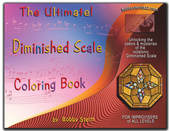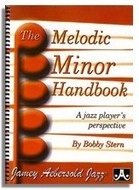She awaits you... on "the bridge"!

"Have You Met Miss Jones?" - a Richard Rogers and Lorenz Hart song classic - was first introduced in 1937 as part of the Broadway musical / political satire, "I'd Rather be Right".
Having been recorded by artists as diverse - in style and era - as Louis Armstrong and Robbie Williams, "Have You Met Miss Jones?" has since become a Jazz Standard, making its way onto the exalted list of 20th Century songs known as the "Great American Songbook".
What sets "Miss Jones" apart from the rest of the pack is her unique bridge in which the key centers modulate in descending Major 3rds (a song's bridge being the eight-bar "B" section - bars #17 thru #24 - of the 32-bar, AABA "standard American popular song" form).
Getting back to "Miss Jones", example #1 below is an exercise sequence over the chord changes of the aforementioned bridge, using a consistent arpeggio shape most of the way. The free, downloadable PDF has this eight-bar sequence in Concert, Bb, Eb and Bass Clef.
Bar #1 is all Bb Major, with bar #2 continuing the shape over Ab-7 Db9, which is the ii-V7 of Gb Maj - the new key center to which it resolves in bar #3 - a Major 3rd down from where we started in Bb. The same pattern continues in bar #4 with E-7 A9, the ii-V7 of D Maj (bar #5), again a Major 3rd down from the previous tonal center. At this point, we have a complete Major 3rds Cycle, which divides the octave into 3 equal parts.
Bars #6 and #7 see a change of direction - ascending a Maj 3rd (Ab-7 Db9 / Gb Maj) - before moving down a half-step (G-7 C7alt) to the ii-V7 of F Major - bringing us back to the home key and final eight-bar "A-section" of the tune; thus driving "Miss Jones" back home.
Ex. 1 - An exercise sequence over the changes of the bridge of "Have You Met Miss Jones?" (Cycle of Descending Major 3rds)
Ex. 2 below illustrates the same basic Cycle of Descending Major 3rds formula, as utilized by John Coltrane in his previously mentioned originals. The cycle in this example has been transposed to begin on Bb Major, for comparison with Ex. 1.
The first noticeable difference is that this example is half the length - only 4-bars long - compared with the eight on the bridge of "Miss Jones". This was accomplished by 1) holding each chord to two beats, and 2) dispensing with the ii chord in each case, thereby going straight to the Dominant 7th chord of the next tonal center, down a Maj 3rd - exactly as in Ex. 1. This essentially cuts beats 3 & 4 and 1 & 2 from every other pair of measures, resulting in a 4-bar, rather than an eight-bar sequence. Do the math!
The next thing to check out in Ex. 2 is the bass, which descends in whole steps (Bb-Ab-Gb-E-D-C) for the first three bars, and alternates between the root and fifth of each chord. This is from Coltrane's "Satellite", the result of his applying the Cycle of Descending Major 3rds to the standard "How High the Moon". This whole-step movement in the bass is totally logical, since 2 whole steps equal a Major 3rd.
How about the melodic sequence? Starting with the pickup note C, it continues - in descending fashion - with Bb-F-D-Bb, a Bb Maj triad in 1st inversion (1-5-3-1), for the first 2 beats of bar #1; continuing with Ab-Eb-B-Ab, a descending Ab minor triad in 1st inversion, covering a Db7 (5-9-b7-5), with the 5th in the bass.
Ex. 2 - Cycle of Descending Major 3rds with bass descending in whole steps ("Satellite")
"Miss Jones" is still waiting to meet you on the bridge. It looks like she'd already met Coltrane!
B. Stern
*** Changin' Trane's / Retrosteps - The Ultimate Book on Coltrane Changes ***
*** John Coltrane's "Satellite" tenor saxophone solo transcribed. ***
*** A Whole Lotta Sole - Giant Steps 027, sus2, sus4, 125 ***






 RSS Feed
RSS Feed









